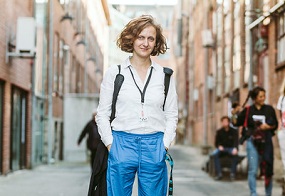Maja Smrekar

Maja graduated from the Department of Sculpture and got her master’s degree from the Department of Video and New Media at the Academy of Fine Arts and Design in Ljubljana. In her projects, she re-examines the concept of life and addresses the radical social changes brought about by development and new technologies, thus discussing the co-habitation of people, animals and machines.
As she engages in research art, she does not work in a studio; instead, she creates in environments which correspond to the interests of her research, i.e. in a biotechnical laboratory, in a robotics laboratory and in the great outdoors. In her creative pursuits, she collaborates with scientists and technologists, and uses certain scientific tools as her art media, thus combining art and science and communicating the continuous involvement of science in every sphere of our lives.
Although she works internationally, she also collaborates regularly with Kapelica Gallery in Ljubljana. Her projects include installations, performances, drawings, video and audio products, and site-specific art. She also channels her thoughts and knowledge through the written and spoken word.
Over the years, she has received many awards for her work. At the Cynetart Festival, she was awarded first prize by the HELLERAU – European Centre for the Arts Dresden (Germany) in 2012; a year later, she was awarded the Golden Bird Award in Ljubljana, and was honourably mentioned at Ars Electronica Festival in Austria. In 2017, she received the Trend Prize for special results in visual creativity, followed in the same year by the Golden Nica Prix at the Ars Electronica Festival for her work K-9_topologija, which is the most resounding international award in media art, recognising her links with technology, science and the humanities. The central theme of this project is the question of what it means to be human in today’s capitalist world, to which the artist provides the answer that the animalism we carry inside is actually the characteristic that makes us the most human. In 2018, she received the Prešeren Fund Award for this project.
